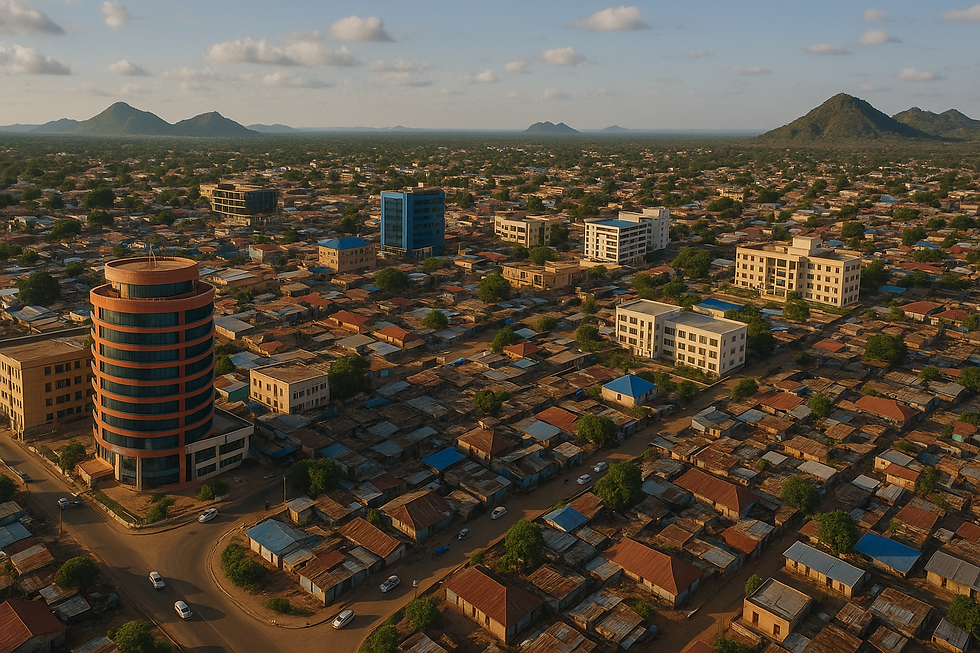North Macedonia’s ESG Moment: A Small Country’s Big Bet on Sustainability
- tinchichan

- Jul 31
- 5 min read
In the heart of the Balkans, a small landlocked country is quietly trying to do something big: transform its economy, society, and institutions through sustainability. North Macedonia, long overshadowed by regional instability and identity debates, is now stepping into the ESG spotlight—not with headlines, but with hard policy work.
With ambitious climate goals, a bold energy transition plan, and a growing commitment to transparency and inclusion, North Macedonia is carving out a new role for itself. One that says: even small nations can lead the way on Environmental, Social, and Governance transformation.

“We are not just aligning with EU standards—we are trying to leapfrog,” says Kaja Shukova, Minister of Environment and Physical Planning. “We see ESG not as a burden, but as a bridge.”
1. ESG in Context: A Transition Economy Turns Toward the Future
North Macedonia’s path to sustainability is shaped by its recent history:
Independence in 1991
EU candidate status since 2005
NATO member since 2020
Ongoing negotiations over EU accession, identity, and rule of law
Key macro indicators:
GDP (2024 est.): $15.6 billion
Population: 1.8 million
Unemployment: 12.5% (youth: ~30%)
Public debt: ~59% of GDP
Gini coefficient: 0.32
Despite its size, North Macedonia is embracing ESG as a strategic framework for:
EU convergence
Energy security and climate resilience
Attracting green finance and regional investment
Rebuilding trust in public institutions
2. Environmental Sustainability: From Lignite to Renewables
2.1 Energy Transition and Climate Goals
North Macedonia’s energy history is rooted in coal and hydropower. But the future is electric—and green.
Targets under the National Energy and Climate Plan (NECP):
Coal phase-out by 2030
42% renewable energy share in gross final consumption by 2030
Net-zero by 2050 (in line with EU Green Deal)
Progress to date:
Renewables account for ~25% of electricity production
Hydropower is the largest source, but solar and wind are rising fast
First solar park at REK Oslomej (former coal site) launched in 2022
Energy reforms include:
Unbundling and liberalization of the energy market
Renewable auctions and feed-in premium schemes
€1 billion pipeline of clean energy investments with EBRD, IFC, and USAID
“We are transitioning not only from coal—but from dependence to resilience,” says Bekim Neziri, energy transition advisor and former minister.
2.2 Climate Adaptation and Natural Resources
North Macedonia is climate-vulnerable:
Agriculture accounts for ~10% of GDP, but faces drought and soil degradation
Forests cover 38% of the country, but wildfires are rising
Water resources are under stress from glacial retreat and pollution
Adaptation measures:
National Climate Adaptation Strategy (2021–2030)
Expansion of irrigation systems and climate-resilient crops
Afforestation and biodiversity corridors along Vardar Valley
The country is also exploring nature-based solutions and carbon farming pilots, with technical support from FAO and UNEP.
3. Social Sustainability: Bridging Divides, Building Inclusion
3.1 Social Protection and Human Development
North Macedonia’s social fabric is defined by ethnic, geographic, and generational divides. ESG offers a framework to bridge them.
Social progress:
Universal healthcare coverage, though quality varies
Digitalization of social assistance programs (e.g., MyCash)
Conditional cash transfers tied to school attendance and maternal health
Yet challenges persist:
High youth unemployment and emigration
Rural-urban gaps in access to education
Roma and ethnic Albanian communities face systemic exclusion
Key inclusion initiatives:
Roma Strategy (2022–2030) with EU support
Gender Equality Law (2023 update) mandates equal pay and representation
Youth Guarantee Program (ILO/EU pilot) offers training-to-jobs pathways
3.2 Gender, Labor, and ESG Metrics
Women in North Macedonia face a double bind: low participation and low representation.
Female labor force participation: ~44%
Women in parliament: ~38%, but low in executive roles
Gender pay gap: ~16% (data varies)
The government is pushing:
Gender-responsive budgeting across ministries
ESG-linked public procurement rules
Mandatory social and gender impact assessments for major infrastructure projects
4. Governance and Regulation: EU Alignment, Domestic Execution
4.1 Institutional Integrity and ESG Governance
Governance is North Macedonia’s strongest ESG asset:
Transparency International CPI (2023): Rank 85/180—progress, but still mid-tier
Digital government platforms (e.g., e-Uslugi) improving service delivery
Public procurement reforms tied to OECD SIGMA benchmarks
Recent milestones:
Sustainability Development Council established in 2022
ESG KPIs integrated into municipal budgeting pilots
Open Data Portals launched for climate, education, and emissions
4.2 ESG Regulation and Corporate Transparency
The private sector is still catching up, but progress is underway:
No national ESG disclosure law yet, but alignment with EU’s CSRD is planned for 2025
Central Securities Depository and Skopje Stock Exchange launched voluntary ESG reporting guidelines in 2023
State-owned enterprises (SOEs) now required to report on environmental and social KPIs annually
Challenges:
Most SMEs lack ESG capacity
Low penetration of sustainability assurance providers
Little integration of ESG in banking and credit risk frameworks
5. ESG Finance: Unlocking Green Capital for Development
5.1 Green Bonds and Public Finance Innovation
North Macedonia is preparing to issue its first sovereign green bond by 2025:
Framework in development with World Bank and UNDP
Potential allocation to transport electrification, energy efficiency, and water resilience
Municipalities are also exploring SDG bonds and blended finance to fund:
Green schools
Wastewater treatment plants
Climate-resilient housing
5.2 Private Sector and Multilateral Support
IFIs and donors are key drivers of ESG finance:
EBRD Green Economy Transition (GET) projects exceed €500 million since 2017
USAID and GIZ co-financing ESG-linked SME credit lines
Local banks piloting green mortgages and energy-efficiency loans, especially in Skopje, Bitola, and Tetovo
The National Development Bank is exploring an ESG scorecard system for SME lending in 2025.
6. ESG Case Studies: North Macedonia in Action
Case Study 1: EVN Macedonia – Greening the Grid
National energy distributor
Investing €100 million in smart grids and renewables
Publishes GRI-aligned sustainability reports
Working on Scope 1–3 emissions disclosures for 2025
Case Study 2: Tikves Winery – Sustainable Agri-Tourism
Largest winery in the Balkans
Pioneering organic viticulture and solar-powered irrigation
ESG-linked exports to EU markets
Part of UNDP’s Green Value Chains Program
Case Study 3: City of Skopje – Urban Climate Innovation
Launched Green City Action Plan (GCAP) in partnership with EBRD
Converting 20% of public buses to electric by 2026
Urban tree planting, bike lanes, and air quality sensors
Piloting climate budgeting and SDG-aligned procurement
7. Comparative ESG Snapshot: The Western Balkans in Focus
Indicator (2023) | North Macedonia | Serbia | Albania | Montenegro |
Renewable electricity (%) | 25% | 28% | 39% | 54% |
Sovereign green bond issued | No (planned) | No | No | Yes (2023) |
GHG emissions per capita (tCO₂e) | 4.0 | 5.5 | 2.6 | 3.9 |
ESG disclosure regulation | Partial | None | Partial | Partial |
Female labor force (%) | 44% | 46% | 45% | 48% |
TI Corruption Rank (2023) | 85/180 | 104/180 | 98/180 | 64/180 |
*North Macedonia is mid-pack but gaining ground—especially in governance, energy transition, and ESG policy frameworks.
8. Strategic ESG Risks and Opportunities
Risks
Coal legacy and grid instability
ESG data gaps and low corporate reporting capacity
Climate threats to agriculture and water systems
Political instability risks slowing EU alignment
Opportunities
Finalize and issue a sovereign green bond to fund transition
Develop a national ESG reporting framework for listed and large firms
Scale up climate-smart agriculture and bioeconomy sectors
Position Skopje as a green urban innovation hub
Leverage EU accession to embed ESG in all public investment
Conclusion: ESG as North Macedonia’s Development Compass
For North Macedonia, ESG is more than a checklist—it’s a development strategy, a diplomatic tool, and a generational opportunity. In a region that’s still finding its footing, this small country is showing what’s possible when good governance, green ambition, and social inclusion come together.
If it stays the course, North Macedonia may not just join the EU—it might help redefine what sustainable convergence looks like.



Comments